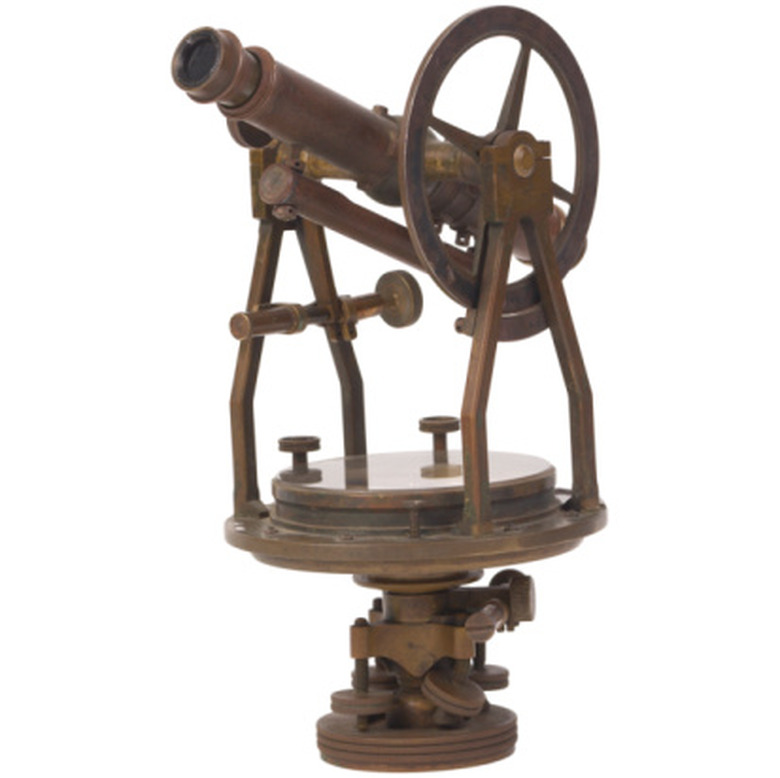How To Construct A Theodolite
A theodolite is an optical instrument based on the telescope that is used for determining the horizontal and vertical angles between two points and for calculating distances. An essential tool in surveying and engineering work, it uses the principle that if two angles and the distance between two points in a triangle are known, then all other dimensions can be determined. In the United States and Canada, they are often called "transits."
Base Protractor
Step 1
Cut the 1 inch by 2 inch cardboard into an arrow shape and glue it to the bottom of the 1-inch by 1-inch post.
Step 2
Position the full-circle protractor in the center of the 8-by-8 plywood and glue in place.
Step 3
Drill through the protractor's center and the plywood.
Step 4
Insert the longer screw through the bottom of the plywood, and place a washer over the end that pokes through.
Step 5
Attach the upright post to the screw, so that the arrow sits flat against the plywood and can turn freely.
Upper Protractor
Step 1
Glue the plastic straw to the straight edge of the half-circle protractor. The straw should stick out about an inch from each end of the protractor.
Step 2
Turn the theodolite on its side and position the flat side of the half-circle protractor three inches from the top of the upright post.
Step 3
Attach the protractor in the center with the shorter screw and washer, ensuring it pivots easily against the post.
Step 4
Turn the theodolite upright and tie one end of the nylon string to the screw protruding from the protractor.
Step 5
Attach the metal fishing weight to the other end so that it hangs freely.
Test for Accuracy
Step 1
Test the accuracy of the theodolite by using it to measure a known height — for example, the height of a house.
Step 2
Place the theodolite on a level surface at a measured distance (the baseline) from the house, and adjust the upright post until the apex of the roof is sighted through the straw.
Step 3
Read the number of degrees on the half-circle protractor directly behind the nylon cord. Given this angle, the known distance from the house, and the angle between house and ground, simple geometry makes it straightforward to calculate the height of the house. Alternately, use a tangent table. Look up the tangent for the angle on the table and multiply that number by the length of the baseline.
Step 4
Use the full-circle protractor for more advanced calculations. The number of degrees indicated by the arrow (the distance the upright post was turned away from 0 degrees to sight the object) is called an azimuth. This principle is used in many practical ways, including navigation, mapping and astronomy.
Things Needed
- 6-inch plastic half-circle protractor
- 6-inch plastic full-circle protractor
- Plastic drinking straw
- Thick cardboard 1 inch by 2 inches
- Wooden post 12 inches by 1 inch square
- Plywood square 8 inches by 8 inches
- Six inches of nylon string
- Small metal fishing weight
- One-inch and 1.5-inch metal screw
- Two washers
- Glue
TL;DR (Too Long; Didn't Read)
Be careful not to move the base from its initial position during sightings. If doing sightings of celestial bodies, be sure to record coordinates, dates and times of each sighting so that their movements can be tracked over time.
Cite This Article
MLA
Staples, Peter. "How To Construct A Theodolite" sciencing.com, https://www.sciencing.com/construct-theodolite-8577736/. 24 April 2017.
APA
Staples, Peter. (2017, April 24). How To Construct A Theodolite. sciencing.com. Retrieved from https://www.sciencing.com/construct-theodolite-8577736/
Chicago
Staples, Peter. How To Construct A Theodolite last modified March 24, 2022. https://www.sciencing.com/construct-theodolite-8577736/
